List of gravitationally rounded objects of the Solar System
This is a list of possibly gravitationally rounded objects of the Solar System, which are objects that have a rounded, ellipsoidal shape due to their own gravity (hydrostatic equilibrium). Their sizes range from former dwarf planets and moons to the planets and the Sun. This list does not include small Solar System bodies, but it does include a sample of possible planetary-mass objects whose shapes have yet to be determined. The Sun's orbital characteristics are listed in relation to the Galactic Center, while all other objects are listed in order of their distance from the Sun.
 |
| Objects |
|---|
| Lists |
| Planets |
|
|
Star
The Sun is a G-type main-sequence star. It contains almost 99.9% of all the mass in the Solar System.[1]
| Sun[2] | ||
|---|---|---|
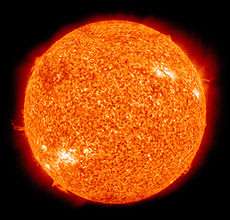 | ||
| Astronomical symbol[q] | ||
| Mean distance from the Galactic Center |
km light years |
~2.5×1017 ~26,000 |
| Mean radius | km :E[f] |
696,342 109.3 |
| Surface area | km2 :E[f] |
6.0877×1012 11,990 |
| Volume | km3 :E[f] |
1.4122×1018 1,300,000 |
| Mass | kg :E[f] |
1.9855×1030 332,978.9 |
| Gravitational parameter | m3/s2 | 1.327×1020 |
| Density | g/cm3 | 1.409 |
| Equatorial gravity | m/s2 | 274.0 |
| Escape velocity | km/s | 617.7 |
| Rotation period | days[g] | 25.38 |
| Orbital period about Galactic Center[3] | million years | 225–250 |
| Mean orbital speed[3] | km/s | ~220 |
| Axial tilt[i] to the ecliptic | deg. | 7.25 |
| Axial tilt[i] to the galactic plane | deg. | 67.23 |
| Mean surface temperature | K | 5,778 |
| Mean coronal temperature[4] | K | 1–2×106 |
| Photospheric composition | H, He, O, C, Fe, S | |
Planets
| Key | ||
|---|---|---|
| * Terrestrial planet |
° Gas giant |
‡ Ice giant |
The 2006 International Astronomical Union (IAU) defines a planet as a body in orbit around the Sun that was large enough to have achieved hydrostatic equilibrium and to have "cleared the neighbourhood around its orbit".[5] The practical meaning of "cleared the neighborhood" is that a planet is comparatively massive enough for its gravitation to control the orbits of all objects in its vicinity. By the IAU's definition, there are eight planets in the Solar System; four terrestrial planets (Mercury, Venus, Earth and Mars) and four giant planets, which can be divided further into two gas giants (Jupiter and Saturn) and two ice giants (Uranus and Neptune). When excluding the Sun, the four giant planets account for more than 99% of the mass of the Solar System.
| *Mercury[6][7] | *Venus[8][9] | *Earth[10][11] | *Mars[12][13] | °Jupiter[14][15] | °Saturn[16][17] | ‡Uranus[18][19] | ‡Neptune[20][21] | ||
|---|---|---|---|---|---|---|---|---|---|
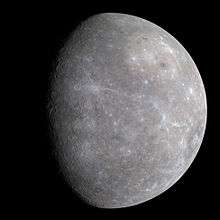 |
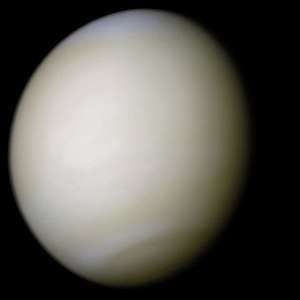 |
 |
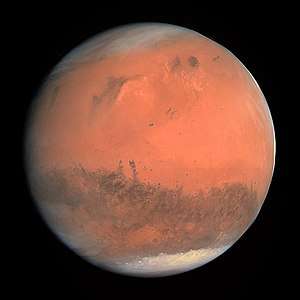 |
 |
 |
_flatten_crop.jpg) | |||
| Astronomical symbol[q] | |||||||||
| Mean distance from the Sun |
km AU |
57,909,175 0.38709893 |
108,208,930 0.72333199 |
149,597,890 1.00000011 |
227,936,640 1.52366231 |
778,412,010 5.20336301 |
1,426,725,400 9.53707032 |
2,870,972,200 19.19126393 |
4,498,252,900 30.06896348 |
| Equatorial radius | km :E[f] |
2,439.64 0.3825 |
6,051.59 0.9488 |
6,378.1 1 |
3,397.00 0.53260 |
71,492.68 11.209 |
60,267.14 9.449 |
25,557.25 4.007 |
24,766.36 3.883 |
| Surface area | km2 :E[f] |
75,000,000 0.1471 |
460,000,000 0.9020 |
510,000,000 1 |
140,000,000 0.2745 |
64,000,000,000 125.5 |
44,000,000,000 86.27 |
8,100,000,000 15.88 |
7,700,000,000 15.10 |
| Volume | km3 :E[f] |
6.083×1010 0.056 |
9.28×1011 0.857 |
1.083×1012 1 |
1.6318×1011 0.151 |
1.431×1015 1,321.3 |
8.27×1014 763.62 |
6.834×1013 63.102 |
6.254×1013 57.747 |
| Mass | kg :E[f] |
3.302×1023 0.055 |
4.8690×1024 0.815 |
5.972×1024 1 |
6.4191×1023 0.107 |
1.8987×1027 318 |
5.6851×1026 95 |
8.6849×1025 14.5 |
1.0244×1026 17 |
| Gravitational parameter | m3/s2 | 2.203×1013 | 3.249×1014 | 3.986×1014 | 4.283×1013 | 1.267×1017 | 3.793×1016 | 5.794×1015 | 6.837×1015 |
| Density | g/cm3 | 5.43 | 5.24 | 5.52 | 3.940 | 1.33 | 0.70 | 1.30 | 1.76 |
| Equatorial gravity | m/s2 | 3.70 | 8.87 | 9.78 | 3.71 | 23.12 | 8.96 | 8.69 | 11.00 |
| Escape velocity | km/s | 4.25 | 10.36 | 11.18 | 5.02 | 59.54 | 35.49 | 21.29 | 23.71 |
| Rotation period[g] | days | 58.646225 | 243.0187 | 0.99726968 | 1.02595675 | 0.41354 | 0.44401 | 0.71833 | 0.67125 |
| Orbital period[g] | days years |
87.969 0.2408467 |
224.701 0.61519726 |
365.256363 1.000702364 |
686.971 1.8808476 |
4,332.59 11.862615 |
10,759.22 29.447498 |
30,688.5 84.016846 |
60,182 164.79132 |
| Mean orbital speed | km/s | 47.8725 | 35.0214 | 29.7859 | 24.1309 | 13.0697 | 9.6724 | 6.8352 | 5.4778 |
| Eccentricity | 0.20563069 | 0.00677323 | 0.01671022 | 0.09341233 | 0.04839266 | 0.05415060 | 0.04716771 | 0.00858587 | |
| Inclination[f] | deg. | 7.00 | 3.39 | 0[10] | 1.85 | 1.31 | 2.48 | 0.76 | 1.77 |
| Axial tilt[i] | deg. | 0.0 | 177.3[h] | 23.44 | 25.19 | 3.12 | 26.73 | 97.86[h] | 28.32 |
| Mean surface temperature | K | 440–100 | 730 | 287 | 227 | 152 [j] | 134 [j] | 76 [j] | 73 [j] |
| Mean air temperature[k] | K | 288 | 165 | 135 | 76 | 73 | |||
| Atmospheric composition | He, Na+ P+ |
CO2, N2, SO2 | N2, O2, Ar, CO2 | CO2, N2 Ar |
H2, He | H2, He | H2, He CH4 |
H2, He CH4 | |
| Number of known moons[v] | 0 | 0 | 1 | 2 | 79 | 82 | 27 | 14 | |
| Rings? | No | No | No | No | Yes | Yes | Yes | Yes | |
| Planetary discriminant[l][o] | 9.1×104 | 1.35×106 | 1.7×106 | 1.8×105 | 6.25×105 | 1.9×105 | 2.9×104 | 2.4×104 | |
Dwarf planets
| Key | |||||
|---|---|---|---|---|---|
| † asteroid belt |
‡ trans-Neptunian | ||||
Dwarf planets are bodies that are massive and warm enough to have achieved hydrostatic equilibrium, but have not cleared their neighbourhoods of similar objects. Since 2008, there have been five dwarf planets recognized by the IAU, though of these only Ceres, which orbits in the asteroid belt between the orbits of Mars and Jupiter, has been confirmed.[ae] The others all orbit beyond Neptune. Astronomers generally agree that several other trans-Neptunian objects may be large enough to be dwarf planets, given current uncertainties. It seems that dark, low-density objects like Salacia retain internal porosity from their formation, and thus are not planetary bodies.[22] Both Quaoar and Orcus have moons that have allowed their mass and density to be determined, and they are either bright enough to suggest resurfacing and thus planetary geology at least at some point in their past, or are dense enough that they are clearly solid bodies and thus at least potentially dwarf planets.
| †Ceres[23] | ‡Pluto[24][25] | ‡Haumea[26][27][28] | ‡Makemake[29][30] | ‡Eris[31] | ||
|---|---|---|---|---|---|---|
_(cropped).jpg) |
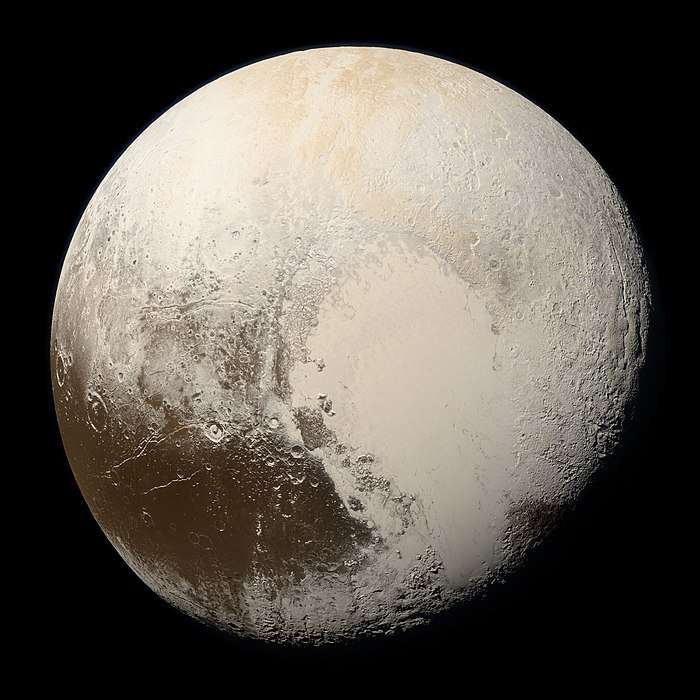 |
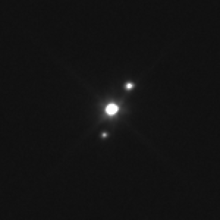 |
.jpg) |
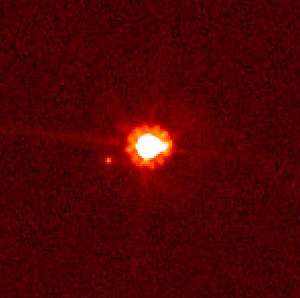 | ||
| Astronomical symbol[q] | ||||||
| Minor planet number | 1 | 134340 | 136108 | 136472 | 136199 | |
| Mean distance from the Sun |
km AU |
413,700,000 2.766 |
5,906,380,000 39.482 |
6,484,000,000 43.335 |
6,850,000,000 45.792 |
10,210,000,000 67.668 |
| Mean radius | km :E[f] |
473 0.0742 |
1,187[32] 0.186 |
816 (2100 × 1680 × 1074) 0.13[33][34] |
715 0.11[35] |
1,163 0.18[36] |
| Volume | km3 :E[f] |
4.21×108 0.00039[b] |
6.99×109 0.0065 |
1.98×109 0.0018 |
1.7×109 0.0016[b] |
6.59×109 0.0061[b] |
| Surface area | km2 :E[f] |
2,770,000 0.0054[a] |
17,700,000 0.035 |
8,140,000 0.016[z] |
6,900,000 0.0135[a] |
17,000,000 0.0333[a] |
| Mass | kg :E[f] |
9.39×1020 0.00016 |
1.305×1022 0.0022 |
4.01 ± 0.04×1021 0.0007[37] |
< 4.4 ×1021
< 0.0007 |
1.7×1022 0.0028[38] |
| Gravitational parameter | m3/s2 | 6.263 × 1010 | 8.710 × 1011 | 2.674 × 1011 | < 2.9366 × 1011 | 1.108 × 1012 |
| Density | g/cm3 | 2.16 | 1.87 | 2.02[33] | < 2.933 | 2.25[c] |
| Equatorial gravity | m/s2 | 0.27[d] | 0.62 | 0.63[d] | < 0.57 | ~0.8[d] |
| Escape velocity | km/s[e] | 0.51 | 1.21 | 0.91 | < 0.91 | 1.37 |
| Rotation period[g] | days | 0.95111 | 6.38723 | 0.16315 | 0.95111 | 1.0792 |
| Orbital period[g] | years | 4.599 | 247.92065 | 285.4 | 309.9 | 557 |
| Mean orbital speed | km/s | 17.882 | 4.7490 | 4.484[o] | 4.4[o] | 3.436[n] |
| Eccentricity | 0.080 | 0.24880766 | 0.18874 | 0.159 | 0.44177 | |
| Inclination[f] | deg. | 10.587 | 17.14175 | 28.19 | 28.96 | 44.187 |
| Axial tilt[i] | deg. | 4 | 119.59[h] | ? | ? | ? |
| Mean surface temperature[w] | K | 167[39] | 40[40] | <50[41] | 30 | 30 |
| Atmospheric composition | H2O | N2, CH4, CO | ? | N2, CH4[42] | N2, CH4[43] | |
| Number of known moons[v] | 0 | 5 | 2[44] | 1[45] | 1[46] | |
| Planetary discriminant[l][o] | 0.33 | 0.077 | 0.023 | 0.02 | 0.10 | |
Of the remaining trans-Neptunian objects, the most likely dwarf planets include:
| Orcus[47] | Salacia[48] | Quaoar[49] | Gonggong[50] | Sedna[51] | ||
|---|---|---|---|---|---|---|
 |
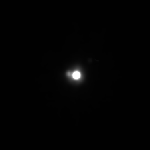 |
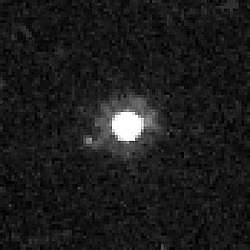 |
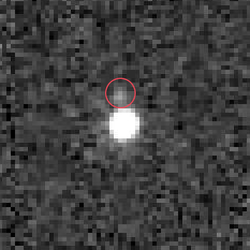 |
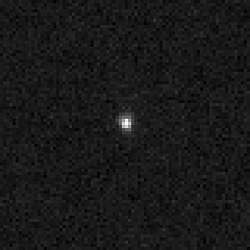 | ||
| Minor-planet number | 90482 | 120347 | 50000 | 225088 | 90377 | |
| Semi-major axis | km AU |
5,896,946,000 39.419 |
6,310,600,000 42.18 |
6,535,930,000 43.69 |
10,072,433,340 67.33 |
78,668,000,000 525.86 |
| Mean radius[s] | km :E[f] |
458.5[52] 0.0720 |
423[53] 0.0664 |
560.5[54] 0.0870 |
615[55] 0.0982 |
497.5[56] 0.0780 |
| Surface area[a] | km2 :E[f] |
2,641,700 0.005179 |
2,248,500 0.004408 |
3,948,000 0.007741 |
4,932,300 0.009671 |
3,110,200 0.006098 |
| Volume[b] | km3 :E[f] |
403,744,500 0.000373 |
317,036,800 0.000396 |
737,591,000 0.000681 |
1,030,034,600 0.000951 |
515,784,000 0.000476 |
| Mass[t] | kg :E[f] |
6.32×1020[57] 0.0001 |
4.9×1020[53] 0.0001 |
1.41×1021[58] 0.0003 |
1.75×1021[55] 0.0003 |
? |
| Density[t] | g/cm3 | 1.5±0.3[57] | 1.50±0.12[53] | 1.99±0.46[58] | 1.74±0.16 | ? |
| Equatorial gravity[d] | m/s2 | 0.27 | 0.18 | 0.24 | 0.285 | ? |
| Escape velocity[e] | km/s | 0.50 | 0.39 | 0.45 | 0.604 | ? |
| Rotation period[g] | days | 0.5495 | 0.25375 | 0.73662 | 0.93333 | 0.42804[59] |
| Orbital period[g] | years | 247.492 | 273.98 | 287.97 | 552.52 | 12,059.06 |
| Mean orbital speed | km/s | 4.68 | 4.57 | 4.52 | 3.63 | 1.04 |
| Eccentricity | 0.22552 | 0.106 | 0.038 | 0.5064 | 0.855 | |
| Inclination[f] | deg. | 22.5 | 23.92 | 7.988 | 30.74 | 11.93 |
| Mean surface temperature[w] | K | ~42 | ~43 | ~41 | ~30 | ~12 |
| Number of known moons | 1[60] | 1 | 1[61] | 1 | 0 | |
| Planetary discriminant[l][o] | 0.003 | <0.1 | 0.0015 | <0.1 | ?[x] | |
| Absolute magnitude (H) | 2.3 | 4.1 | 2.71 | 1.8 | 1.5 | |
Satellites
| Key | |||||
|---|---|---|---|---|---|
| 🜨 Satellite of Earth |
♃ Satellite of Jupiter |
♄ Satellite of Saturn |
⛢ Satellite of Uranus |
♆ Satellite of Neptune |
♇ Satellite of Pluto |
There are 19 natural satellites in the Solar System that are known to be massive enough to be close to hydrostatic equilibrium. Alan Stern calls these satellite planets, although the term major moon is more common.
Several of these were once in equilibrium but are no longer: these include Earth's moon and all of the moons listed for Saturn apart from Titan and Rhea. The status of the moons of Uranus, Pluto and Eris are uncertain. Other moons that were once in equilibrium but are no longer very round, such as Saturn's Phoebe, are not included. Satellites are listed first in order from the Sun, and second in order from their parent body.
| 🜨Moon[62] | ♃Io[63] | ♃Europa[64] | ♃Ganymede[65] | ♃Callisto[66] | ♄Mimas[p] | ♄Enceladus[p] | ♄Tethys[p] | ♄Dione[p] | ♄Rhea[p] | ||
|---|---|---|---|---|---|---|---|---|---|---|---|
 |
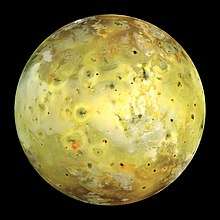 |
 |
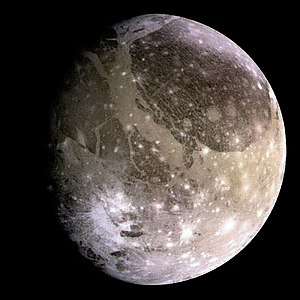 |
 |
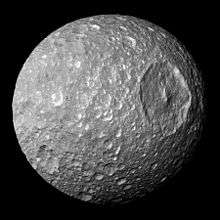 |
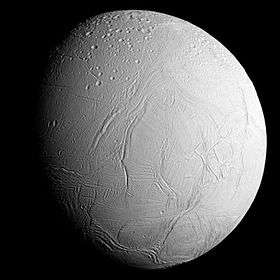 |
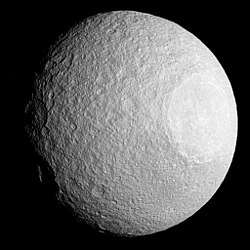 |
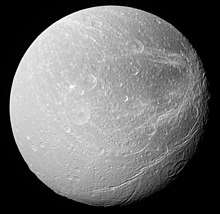 |
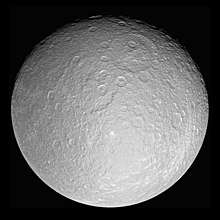 | ||
| Astronomical symbol[q] | |||||||||||
| Mean distance from primary: |
km | 384,399 | 421,600 | 670,900 | 1,070,400 | 1,882,700 | 185,520 | 237,948 | 294,619 | 377,396 | 527,108 |
| Mean radius | km :E[f] |
1,737.1 0.272 |
1,815 0.285 |
1,569 0.246 |
2,634.1 0.413 |
2,410.3 0.378 |
198.30 0.031 |
252.1 0.04 |
533 0.084 |
561.7 0.088 |
764.3 0.12 |
| Surface area[a] | 1×106 km2 | 37.93 | 41.910 | 30.9 | 87.0 | 73 | 0.49 | 0.799 | 3.57 | 3.965 | 7.337 |
| Volume[b] | 1×109 km3 | 22 | 25.3 | 15.9 | 76 | 59 | 0.033 | 0.067 | 0.63 | 0.8 | 1.9 |
| Mass | 1×1022 kg | 7.3477 | 8.94 | 4.80 | 14.819 | 10.758 | 0.00375 | 0.0108 | 0.06174 | 0.1095 | 0.2306 |
| Density[c] | g/cm3 | 3.3464 | 3.528 | 3.01 | 1.936 | 1.83 | 1.15 | 1.61 | 0.98 | 1.48 | 1.23 |
| Equatorial gravity[d] | m/s2 | 1.622 | 1.796 | 1.314 | 1.428 | 1.235 | 0.0636 | 0.111 | 0.145 | 0.231 | 0.264 |
| Escape velocity[e] | km/s | 2.38 | 2.56 | 2.025 | 2.741 | 2.440 | 0.159 | 0.239 | 0.393 | 0.510 | 0.635 |
| Rotation period | days[g] | 27.321582 (sync)[m] |
1.7691378 (sync) |
3.551181 (sync) |
7.154553 (sync) |
16.68902 (sync) |
0.942422 (sync) |
1.370218 (sync) |
1.887802 (sync) |
2.736915 (sync) |
4.518212 (sync) |
| Orbital period about primary | days[g] | 27.32158 | 1.769138 | 3.551181 | 7.154553 | 16.68902 | 0.942422 | 1.370218 | 1.887802 | 2.736915 | 4.518212 |
| Mean orbital speed[o] | km/s | 1.022 | 17.34 | 13.740 | 10.880 | 8.204 | 14.32 | 12.63 | 11.35 | 10.03 | 8.48 |
| Eccentricity | 0.0549 | 0.0041 | 0.009 | 0.0013 | 0.0074 | 0.0202 | 0.0047 | 0.02 | 0.002 | 0.001 | |
| Inclination to primary's equator | deg. | 18.29–28.58 | 0.04 | 0.47 | 1.85 | 0.2 | 1.51 | 0.02 | 1.51 | 0.019 | 0.345 |
| Axial tilt[i][u] | deg. | 6.68 | 0 | 0 | 0–0.33[67] | 0 | 0 | 0 | 0 | 0 | 0 |
| Mean surface temperature[w] | K | 220 | 130 | 102 | 110[68] | 134 | 64 | 75 | 64 | 87 | 76 |
| Atmospheric composition | Ar, He Na, K, H |
SO2[69] | O2[70] | O2[71] | O2, CO2[72] | H2O, N2 CO2, CH4[73] |
|||||
| Rings? | No | No | No | No | No | No | No | No | No | Yes? | |
| ♄Titan[p] | ♄Iapetus[p] | ⛢Miranda[r] | ⛢Ariel[r] | ⛢Umbriel[r] | ⛢Titania[r] | ⛢Oberon[r] | ♆Triton[74] | ♇Charon[24] | ||
|---|---|---|---|---|---|---|---|---|---|---|
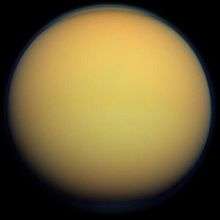 |
 |
 |
.jpg) |
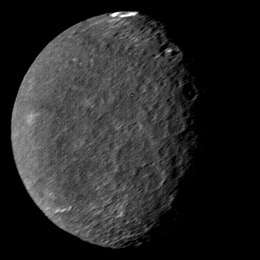 |
_color%2C_edited.jpg) |
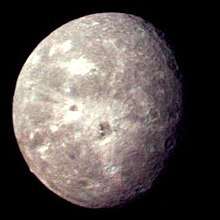 |
.jpg) |
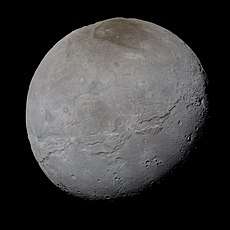 | ||
| Mean distance from primary: |
km | 1,221,870 | 3,560,820 | 129,390 | 190,900 | 266,000 | 436,300 | 583,519 | 354,759 | 17,536 |
| Mean radius | km :E[f] |
2,576 0.404 |
735.60 0.115 |
235.8 0.037 |
578.9 0.091 |
584.7 0.092 |
788.9 0.124 |
761.4 0.119 |
1,353.4 0.212 |
603.5 0.095 |
| Surface area[a] | 1×106 km2 | 83.0 | 6.7 | 0.70 | 4.211 | 4.296 | 7.82 | 7.285 | 23.018 | 4.580 |
| Volume[b] | 1×109 km3 | 71.6 | 1.67 | 0.055 | 0.81 | 0.84 | 2.06 | 1.85 | 10 | 0.92 |
| Mass | 1×1022 kg | 13.452 | 0.18053 | 0.00659 | 0.135 | 0.12 | 0.35 | 0.3014 | 2.14 | 0.152 |
| Density[c] | g/cm3 | 1.88 | 1.08 | 1.20 | 1.67 | 1.40 | 1.72 | 1.63 | 2.061 | 1.65 |
| Equatorial gravity[d] | m/s2 | 1.35 | 0.22 | 0.08 | 0.27 | 0.23 | 0.39 | 0.35 | 0.78 | 0.28 |
| Escape velocity[e] | km/s | 2.64 | 0.57 | 0.19 | 0.56 | 0.52 | 0.77 | 0.73 | 1.46 | 0.58 |
| Rotation period | days[g] | 15.945 (sync)[m] |
79.322 (sync) |
1.414 (sync) |
2.52 (sync) |
4.144 (sync) |
8.706 (sync) |
13.46 (sync) |
5.877 (sync) |
6.387 (sync) |
| Orbital period about primary | days | 15.945 | 79.322 | 1.4135 | 2.520 | 4.144 | 8.706 | 13.46 | 5.877 | 6.387 |
| Mean orbital speed[o] | km/s | 5.57 | 3.265 | 6.657 | 5.50898 | 4.66797 | 3.644 | 3.152 | 4.39 | 0.2 |
| Eccentricity | 0.0288 | 0.0286 | 0.0013 | 0.0012 | 0.005 | 0.0011 | 0.0014 | 0.00002 | 0.0022 | |
| Inclination to primary's equator | deg. | 0.33 | 14.72 | 4.22 | 0.31 | 0.36 | 0.14 | 0.10 | 157[h] | 0.001 |
| Axial tilt[i][u] | deg. | 0 | 0 | 0 | 0 | 0 | 0 | 0 | 0 | ? |
| Mean surface temperature[w] | K | 93.7[75] | 130 | 59 | 58 | 61 | 60 | 61 | 38[76] | 53 |
| Atmospheric composition | N2, CH4[77] | N2, CH4[78] | ||||||||
Notes
Unless otherwise cited:[ac]
- ^ The planetary discriminant for the planets is taken from material published by Stephen Soter.[79] Planetary discriminants for Ceres, Pluto and Eris taken from Soter, 2006. Planetary discriminants of all other bodies calculated from the Kuiper belt mass estimate given by Lorenzo Iorio.[80]
- ^ Saturn satellite info taken from NASA Saturnian Satellite Fact Sheet.[81]
- ^ Astronomical symbols for all listed objects except Ceres taken from NASA Solar System Exploration.[82] Symbol for Ceres was taken from material published by James L. Hilton.[83] The Moon is the only natural satellite with an astronomical symbol, and Pluto and Ceres the only dwarf planets.
- ^ Uranus satellite info taken from NASA Uranian Satellite Fact Sheet.[84]
- ^ Radii for plutoid candidates taken from material published by John A. Stansberry et al.[36]
- ^ Axial tilts for most satellites assumed to be zero in accordance with the Explanatory Supplement to the Astronomical Almanac: "In the absence of other information, the axis of rotation is assumed to be normal to the mean orbital plane."[85]
- ^ Natural satellite numbers taken from material published by Scott S. Sheppard.[86]
Manual calculations (unless otherwise cited)
- ^ Surface area A derived from the radius using , assuming sphericity.
- ^ Volume V derived from the radius using , assuming sphericity.
- ^ Density derived from the mass divided by the volume.
- ^ Surface gravity derived from the mass m, the gravitational constant G and the radius r: G*m/r2 .
- ^ Escape velocity derived from the mass m, the gravitational constant G and the radius r: sqrt((2*G*m)/r) .
- ^ Orbital speed is calculated using the mean orbital radius and the orbital period, assuming a circular orbit.
- ^ Assuming a density of 2.0
- ^ Calculated using the formula where Teff =54.8 K at 52 AU, is the geometric albedo, q=0.8 is the phase integral, and is the distance from the Sun in AU. This formula is a simplified version of that in section 2.2 of Stansberry et al., 2007,[36] where emissivity and beaming parameter were assumed equal unity, and was replaced with 4 accounting for the difference between circle and sphere. All parameters mentioned above were taken from the same paper.
- ^ Calculated using the formula , where H is the absolute magnitude, p is the geometric albedo and D is the diameter in km, and assuming an albedo of 0.15, as per Dan Bruton.[87]
- ^ Mass derived from the density multiplied by the volume.
Individual calculations
- ^ Derived from density
- ^ Surface area was calculated using the formula for a scalene ellipsoid:
- where is the modular angle, or angular eccentricity; and , are the incomplete elliptic integrals of the first and second kind, respectively. The values 980 km, 759 km, and 498 km were used for a, b, and c respectively.
Other notes
- ^ Relative to Earth
- ^ Sidereal
- ^ Retrograde
- ^ The inclination of the body's equator from its orbit.
- ^ At pressure of 1 bar
- ^ At sea level
- ^ The ratio between the mass of the object and those in its immediate neighborhood. Used to distinguish between a planet and a dwarf planet.
- ^ This object's rotation is synchronous with its orbital period, meaning that it only ever shows one face to its primary.
- ^ Objects' planetary discriminants based on their similar orbits to Eris. Sedna's population is currently too little-known for a planetary discriminant to be determined.
- ^ Proteus average diameter: 210 km;[74] Mimas average diameter: 199 km[81]
- ^ "Unless otherwise cited" means that the information contained in the citation is applicable to an entire line or column of a chart, unless another citation specifically notes otherwise.
- ^ Gravitational measurements by the Dawn orbiter have demonstrated that Ceres is in hydrostatic equilibrium.[88] None of the other putative dwarf planets have been observed this closely, though Pluto and Eris are universally assumed to be in equilibrium as well.
References
- Woolfson, Michael Mark (2000). "The Origin and Evolution of the Solar System". Astronomy & Geophysics. 41 (1): 1.12–1.19. Bibcode:2000A&G....41a..12W. doi:10.1046/j.1468-4004.2000.00012.x.
- NASA Solar System exploration Sun factsheet Archived 2008-01-02 at the Wayback Machine and NASA Sun factsheet Archived 2010-07-15 at the Wayback Machine NASA Retrieved on 2008-11-17 (unless otherwise cited)
- Leong, Stacy (2002). Elert, Glenn (ed.). "Period of the Sun's Orbit around the Galaxy (Cosmic Year)". The Physics Factbook (self-published). Retrieved 2008-06-26.
- Aschwanden, Markus J. (2007). "The Sun". In McFadden, Lucy Ann; Weissman, Paul R.; Johnsson, Torrence V. (eds.). Encyclopedia of the Solar System. Academic Press. p. 80.
- "IAU 2006 General Assembly: Result of the IAU Resolution votes" (Press release). International Astronomical Union. 24 August 2006. news release IAU0603. Archived from the original on 3 January 2007. Retrieved 31 December 2007. ("original IAU news release link". Archived from the original on 2008-02-05. Retrieved 2008-10-06.)
- "NASA Mercury Fact Sheet". NASA. Archived from the original on 6 November 2015. Retrieved 17 November 2008.
- "NASA Solar System Exploration Factsheet". NASA. Retrieved 17 November 2008.
- "NASA Venus Factsheet". NASA. Archived from the original on 10 March 2016. Retrieved 17 November 2008.
- "NASA Solar System Exploration Factsheet". NASA. Archived from the original on 29 September 2006. Retrieved 17 November 2008.
- "NASA Earth factsheet". NASA. Retrieved 17 November 2008.
- "NASA Solar System Exploration Factsheet". NASA. Archived from the original on 27 August 2009. Retrieved 17 November 2008.
- "NASA Mars Factsheet". NASA. Archived from the original on 12 June 2010. Retrieved 17 November 2008.
- "NASA Mars Solar System Exploration Factsheet". NASA. Retrieved 17 November 2008.
- "NASA Jupiter factsheet". NASA. Archived from the original on 5 October 2011. Retrieved 17 November 2008.
- "NASA Solar System Exploration Factsheet". NASA. Retrieved 17 November 2008.
- "NASA Saturn factsheet". NASA. Archived from the original on 21 August 2011. Retrieved 17 November 2008.
- "NASA Solar System Exploration Saturn Factsheet". NASA. Retrieved 17 November 2008.
- "NASA Uranus Factsheet". NASA. Archived from the original on 11 August 2011. Retrieved 17 November 2008.
- "NASA Solar System Exploration Uranus Factsheet". NASA. Retrieved 17 November 2008.
- "NASA Neptune Factsheet". NASA. Retrieved 17 November 2008.
- "NASA Solar System Exploration Neptune Factsheet". NASA. Retrieved 17 November 2008.
- Grundy, W.M.; Noll, K.S.; Buie, M.W.; Benecchi, S.D.; Ragozzine, D.; Roe, H.G. (2019). "The mutual orbit, mass, and density of trans-Neptunian binary Gǃkúnǁʼhòmdímà ((229762) 2007 UK126)". Icarus. 334: 30–38. doi:10.1016/j.icarus.2018.12.037.
- "NASA Asteroid Factsheet". NASA. Archived from the original on 18 January 2010. Retrieved 17 November 2008.
- "NASA Pluto factsheet". NASA. Retrieved 17 November 2008.
- "NASA Solar System Exploration Pluto Factsheet". NASA. Retrieved 17 November 2008.
- Lockwood, Alexandra C.; Brown, Michael E.; Stansberry, John A. (2014). "The Size and Shape of the Oblong Dwarf Planet Haumea". Earth, Moon, and Planets. 111 (3–4): 127–137. arXiv:1402.4456. Bibcode:2014EM&P..111..127L. doi:10.1007/s11038-014-9430-1.
- Rabinowitz, David L.; Barkume, Kristina M.; Brown, Michael E.; Roe, Henry G.; Schwartz, Michael; Tourtellotte, Suzanne W.; Trujillo, Chadwick A. (2006). "Photometric Observations Constraining the Size, Shape, and Albedo of 2003 EL61, a rapidly rotating, Pluto-sized object in the Kuiper Belt". The Astrophysical Journal. 639 (2): 1238–1251. arXiv:astro-ph/0509401. Bibcode:2006ApJ...639.1238R. doi:10.1086/499575.
- "Jet Propulsion Laboratory Small-Body Database Browser: 136108 Haumea". NASA's Jet Propulsion Laboratory. Retrieved 13 November 2008.
2008-05-10 last obs.
- Buie, Marc W. (5 April 2008). "Orbit fit and astrometric record for 136472". Space Science Department. SwRI. Retrieved 13 July 2008.
- "NASA Small Bodies Database Browser: 136472 Makemake (2005 FY9)". NASA JPL. Retrieved 2008-10-03. (unless otherwise cited)
- "NASA Small Body Database Browser: Eris". NASA JPL. Retrieved 2008-11-13. (unless otherwise cited)
- Stern, S.A.; Grundy, W.; McKinnon, W.B.; Weaver, H.A.; Young, L.A. (15 December 2017). "The Pluto System After New Horizons". Annual Review of Astronomy and Astrophysics. 56: 357–392. arXiv:1712.05669. Bibcode:2018ARA&A..56..357S. doi:10.1146/annurev-astro-081817-051935.
- Dunham, E. T.; Desch, S. J.; Probst, L. (April 2019). "Haumea's Shape, Composition, and Internal Structure". The Astrophysical Journal. 877 (1): 11. arXiv:1904.00522. Bibcode:2019ApJ...877...41D. doi:10.3847/1538-4357/ab13b3.
- Ortiz, J. L.; Santos-Sanz, P.; Sicardy, B.; Benedetti-Rossi, G.; Bérard, D.; Morales, N.; et al. (2017). "The size, shape, density and ring of the dwarf planet Haumea from a stellar occultation". Nature. 550 (7675): 219–223. Bibcode:2017Natur.550..219O. doi:10.1038/nature24051. hdl:10045/70230. PMID 29022593.
- Brown, Michael) E. (2013). "On the size, shape, and density of dwarf planet Makemake". The Astrophysical Journal. 767 (1): L7. arXiv:1304.1041. Bibcode:2013ApJ...767L...7B. doi:10.1088/2041-8205/767/1/L7.
- Stansberry, John A.; Grundy, Will M.; Brown, Michael E.; Cruikshank, Dale P.; Spencer, John; Trilling, David; Margot, Jean-Luc (2007). "Physical Properties of Kuiper Belt and Centaur Objects: Constraints from Spitzer Space Telescope". The Solar System Beyond Neptune: 161. arXiv:astro-ph/0702538. Bibcode:2008ssbn.book..161S.
- Brown, Michael E.; Bouchez, Antonin H.; Rabinowitz, David L.; Sari, Re'em; Trujillo, Chadwick A.; van Dam, Marcos A.; et al. (October 2005). "Keck Observatory laser guide star adaptive optics discovery and characterization of a satellite to large Kuiper belt object 2003 EL61". The Astrophysical Journal Letters. 632 (L45): L45. Bibcode:2005ApJ...632L..45B. doi:10.1086/497641.
- Brown, Michael E.; Schaller, Emily L. (15 June 2007). "The Mass of Dwarf Planet Eris". Science. 316 (5831): 1585. Bibcode:2007Sci...316.1585B. doi:10.1126/science.1139415. PMID 17569855. S2CID 21468196.
- Saint-Pé, Olivier; Combes, Michel; Rigaut, François J. (1993). "Ceres surface properties by high-resolution imaging from Earth". Icarus. 105 (2): 271–281. Bibcode:1993Icar..105..271S. doi:10.1006/icar.1993.1125.
- Than, Ker (2006). "Astronomers: Pluto colder than expected". Space.com. Retrieved 5 March 2006 – via CNN.com.
- Trujillo, Chadwick A.; Brown, Michael E.; Barkume, Kristina M.; Schaller, Emily L.; Rabinowitz, David L. (February 2007). "The Surface of 2003 EL61 in the Near Infrared". The Astrophysical Journal. 655 (2): 1172–1178. arXiv:astro-ph/0601618. Bibcode:2007ApJ...655.1172T. doi:10.1086/509861.
- Brown, Michael E.; Barkume, Kristina M.; Blake, Geoffrey A.; Schaller, Emily L.; Rabinowitz, David L.; Roe, Henry G.; Trujillo, Chadwick A. (2007). "Methane and Ethane on the Bright Kuiper Belt Object 2005 FY9" (PDF). The Astronomical Journal. 133 (1): 284–289. Bibcode:2007AJ....133..284B. doi:10.1086/509734.
- Licandro, Javier; Grundy, Will M.; Pinilla-Alonso, Noemi; de Leon, Jerome P. (2006). "Visible spectroscopy of 2003 UB313: evidence for N2 ice on the surface of the largest TNO?" (PDF). Astronomy and Astrophysics. 458 (1): L5–L8. arXiv:astro-ph/0608044. Bibcode:2006A&A...458L...5L. CiteSeerX 10.1.1.257.1298. doi:10.1051/0004-6361:20066028.
- Ragozzine, Darin; Brown, Michael E.; Trujillo, Chadwick A.; Schaller, Emily L. Orbits and Masses of the 2003 EL61 Satellite System. AAS DPS conference 2008. Archived from the original on 18 July 2013. Retrieved 17 October 2008.
- Chang, Kenneth (26 April 2016). "Makemake, the Moonless Dwarf Planet, Has a Moon, After All". New York Times. Retrieved 26 April 2016.
- Brown, Michael E.; van Dam, Marcos A.; Bouchez, Antonin H.; Le Mignant, David; Trujillo, Chadwick A.; Campbell, Randall D.; et al. (2006). "Satellites of the largest Kuiper belt objects". The Astrophysical Journal. 639 (1): L43–L46. arXiv:astro-ph/0510029. Bibcode:2006ApJ...639L..43B. doi:10.1086/501524.
- "JPL Small-Body Database Browser: 90482 Orcus (2004 DW)" (2020-01-04 last obs). Jet Propulsion Laboratory. Retrieved 20 February 2020.
- "JPL Small-Body Database Browser: 120347 Salacia (2004 SB60)" (2019-09-21 last obs). Jet Propulsion Laboratory. Retrieved 20 February 2020.
- "NASA JPL Database Browser: 50000 Quaoar" (2019-08-31 last obs). Jet Propulsion Laboratory. Retrieved 20 February 2020.
- "NASA Small Bodies Database Browser: 225088 Gonggong (2007 OR10)". Jet Propulsion Laboratory. Retrieved 20 February 2020.
- Buie, Marc W. (13 August 2007). "Orbit Fit and Astrometric record for 90377". Deep Ecliptic Survey. Retrieved 17 January 2006.
- Fornasier, Sonia; Lellouch, Emmanuel; Müller, Thomas G.; Santos-Sanz, Pablo; Panuzzo, Pasquale; Kiss, Csaba; et al. (2013). "TNOs are Cool: A survey of the trans-Neptunian region. VIII. Combined Herschel PACS and SPIRE observations of 9 bright targets at 70–500 µm". Astronomy & Astrophysics. 555: A15. arXiv:1305.0449. Bibcode:2013A&A...555A..15F. doi:10.1051/0004-6361/201321329.
- Grundy, W. M.; Noll, K. S.; Roe, H. G.; Buie, M. W.; Porter, S. B.; Parker, A. H.; Nesvorný, D.; Benecchi, S. D.; Stephens, D. C.; Trujillo, C. A. (2019). "Mutual Orbit Orientations of Transneptunian Binaries" (PDF). Icarus. 334: 62–78. Bibcode:2019Icar..334...62G. doi:10.1016/j.icarus.2019.03.035. ISSN 0019-1035.
- Arimatsu, Ko; Ohsawa, Ryou; Hashimoto, George L.; Urakawa, Seitaro; Takahashi, Jun; Tozuka, Miyako; et al. (October 2019). "New constraint on the atmosphere of (50000) Quaoar from a stellar occultation". The Astronomical Journal. 158 (6): 236. arXiv:1910.09988. doi:10.3847/1538-3881/ab5058.
- Kiss, Csaba; Marton, Gabor; Parker, Alex H.; Grundy, Will; Farkas-Takacs, Aniko; Stansberry, John; et al. (13 March 2019). "The mass and density of the dwarf planet (225088) 2007 OR10". arXiv:1903.05439. doi:10.1016/j.icarus.2019.03.013. Cite journal requires
|journal=(help) - Pál, A.; Kiss, C.; Müller, T.G.; Santos-Sanz, P.; Vilenius, E.; Szalai, N.; Mommert, M.; Lellouch, E.; Rengel, M.; Hartogh, P.; Protopapa, S.; Stansberry, J.; Ortiz, J.-L.; Duffard, R.; Thirouin, A.; Henry, F.; Delsanti, A. (2012). ""TNOs are Cool": A survey of the trans-Neptunian region. VII. Size and surface characteristics of (90377) Sedna and 2010 EK139". Astronomy & Astrophysics. 541: L6. arXiv:1204.0899. Bibcode:2012A&A...541L...6P. doi:10.1051/0004-6361/201218874.
- Brown, Michael E.; Ragozzine, Darin; Stansberry, John A.; Fraser, Wesley C. (2009). "The size, density, and formation of the Orcus-Vanth system in the Kuiper belt". Astronomical Journal. 139 (6): 2700. arXiv:0910.4784. Bibcode:2010AJ....139.2700B. doi:10.1088/0004-6256/139/6/2700.
- Braga-Ribas, F.; Sicardy, B.; Ortiz, J. L.; Lellouch, E.; Tancredi, G.; Lecacheux, J.; et al. (August 2013). "The Size, Shape, Albedo, Density, and Atmospheric Limit of Transneptunian Object (50000) Quaoar from Multi-chord Stellar Occultations". The Astrophysical Journal. 773 (1): 13. Bibcode:2013ApJ...773...26B. doi:10.1088/0004-637X/773/1/26. hdl:11336/1641.
- "JPL Small-Body Database Browser: 90377 Sedna (2003 VB12)" (2016-01-12 last obs). Retrieved 28 May 2019.
- "Distant EKO". The Kuiper Belt Electronic newsletter. March 2007. Retrieved 17 November 2008.
- "IAUC 8812: Sats of 2003 AZ_84, (50000), (55637), (90482); V1281 Sco; V1280 Sco". International Astronomical Union. Retrieved 5 July 2011.
- NASA Moon factsheet and NASA Solar System Exploration Moon Factsheet NASA Retrieved on 2008-11-17 (unless otherwise cited)
- "NASA Io Factsheet". NASA. Retrieved 2008-11-16. (unless otherwise cited)
- "NASA Europa Factsheet". NASA. Retrieved 2008-11-16. (unless otherwise cited)
- "NASA Ganymede Factsheet". NASA. Retrieved 2008-11-16. (unless otherwise cited)
- "NASA Callisto Factsheet". NASA. Retrieved 2008-11-16.
- Bills, Bruce G. (2005). "Free and forced obliquities of the Galilean satellites of Jupiter". Icarus. 175 (1): 233–247. Bibcode:2005Icar..175..233B. doi:10.1016/j.icarus.2004.10.028.
- Orton, Glenn S.; Spencer, John R.; Travis, Larry D.; et al. (1996). "Galileo Photopolarimeter-radiometer observations of Jupiter and the Galilean Satellites". Science. 274 (5286): 389–391. Bibcode:1996Sci...274..389O. doi:10.1126/science.274.5286.389.
- Pearl, John C.; Hanel, Rudolf A.; Kunde, Virgil G.; et al. (1979). "Identification of gaseous SO2 and new upper limits for other gases on Io". Nature. 288 (5725): 755. Bibcode:1979Natur.280..755P. doi:10.1038/280755a0.
- Hall, Doyle T.; et al.; Detection of an oxygen atmosphere on Jupiter's moon Europa, Nature, Vol. 373, 1995, pp. 677–679 (accessed 2006-15-04)
- Hall, Doyle T.; Feldman, Paul D.; McGrath, Melissa A.; Strobel, Darrell F. (1998). "The Far-Ultraviolet Oxygen Airglow of Europa and Ganymede". The Astrophysical Journal. 499 (1): 475–481. Bibcode:1998ApJ...499..475H. doi:10.1086/305604. Retrieved on 2008-11-17.
- Liang, Mao-Chang; Lane, Benjamin F.; Pappalardo, Robert T.; et al. (2005). "Atmosphere of Callisto" (PDF). Journal of Geophysical Research. 110 (E02003): E02003. Bibcode:2005JGRE..11002003L. doi:10.1029/2004JE002322. Archived from the original (PDF) on 2009-02-25. Retrieved on 2008-11-17.
- Waite, J. Hunter, Jr.; Combi, Michael R.; Ip, Wing-Huen; et al. (2006). "Cassini Ion and Neutral Mass Spectrometer: Enceladus Plume Composition and Structure". Science. 311 (5766): 1419–1422. Bibcode:2006Sci...311.1419W. doi:10.1126/science.1121290. PMID 16527970. S2CID 3032849. Retrieved on 2008-11-17.
- Triton info taken from NASA Neptunian Satellite Fact Sheet Archived 2011-10-05 at WebCite NASA Retrieved on 2009-01-18 (unless otherwise cited)
- Hasenkopf, Christa A.; Beaver, Melinda R.; Tolbert, Margaret A.; et al. (2007). "Optical Properties of Titan Haze Laboratory Analogs Using Cavity Ring Down Spectroscopy" (PDF). Workshop on Planetary Atmospheres (1376): 51. Bibcode:2007plat.work...51H. Archived from the original (PDF) on 2014-05-26. Retrieved 2007-10-16.
- Tryka, Kimberly; Brown, Robert H.; Anicich, Vincent; et al. (August 1993). "Spectroscopic Determination of the Phase Composition and Temperature of Nitrogen Ice on Triton". Science. 261 (5122): 751–754. Bibcode:1993Sci...261..751T. doi:10.1126/science.261.5122.751. PMID 17757214.
- Niemann, Hasso B.; Atreya, Sushil K.; Bauer, Sven J.; et al. (2005). "The abundances of constituents of Titan's atmosphere from the GCMS instrument on the Huygens probe" (PDF). Nature. 438 (7069): 779–784. Bibcode:2005Natur.438..779N. doi:10.1038/nature04122. hdl:2027.42/62703. PMID 16319830.
- Broadfoot, A. Lyle; Atreya, Sushil K.; Bertaux, Jean-Loup; et al. (1989-12-15). "Ultraviolet Spectrometer Observations of Neptune and Triton". Science. 246 (4936): 1459–1466. Bibcode:1989Sci...246.1459B. doi:10.1126/science.246.4936.1459. PMID 17756000.
- Soter, Stephen (2006-08-16). "What is a Planet?". The Astronomical Journal. 132 (6): 2513–2519. arXiv:astro-ph/0608359. Bibcode:2006AJ....132.2513S. doi:10.1086/508861.
- Iorio, Lorenzo (March 2007). "Dynamical determination of the mass of the Kuiper Belt from motions of the inner planets of the Solar system". Monthly Notices of the Royal Astronomical Society. 375 (4): 1311–1314. arXiv:gr-qc/0609023. Bibcode:2007MNRAS.375.1311I. doi:10.1111/j.1365-2966.2006.11384.x.
- NASA Saturnian Satellite Fact Sheet NASA Retrieved on 2008-11-17
- "NASA Solar System Exploration: Planet Symbols". NASA. Retrieved 2009-01-26.
- Hilton, James L. "When did asteroids become minor planets?" (PDF). U.S. Naval Observatory. Retrieved 2008-10-25.
- "NASA Uranian Satellite Fact Sheet". NASA. Archived from the original on 2010-01-18. Retrieved 2008-11-17.
- Seidelmann, P. Kenneth, ed. (1992). Explanatory Supplement to the Astronomical Almanac. University Science Books. p. 384.
- Sheppard, Scott S. "The Jupiter Satellite Page". Carnegie Institution for Science, Department of Terrestrial Magnetism. Archived from the original on 2013-03-09. Retrieved 2008-04-02.
- Bruton, Dan. "Conversion of Absolute Magnitude to Diameter for Minor Planets". Department of Physics & Astronomy at Stephen F. Austin State University. Archived from the original on 2010-03-23. Retrieved 2009-01-20.
- Park, R. S.; Konopliv, A. S.; Bills, B. G.; Rambaux, N.; Castillo-Rogez, J. C.; Raymond, C. A.; Vaughan, A. T.; Ermakov, A. I.; Zuber, M. T.; Fu, R. R.; Toplis, M. J.; Russell, C. T.; Nathues, A.; Preusker, F. (2016-08-03). "A partially differentiated interior for (1) Ceres deduced from its gravity field and shape". Nature. 537 (7621): 515–517. Bibcode:2016Natur.537..515P. doi:10.1038/nature18955. PMID 27487219.